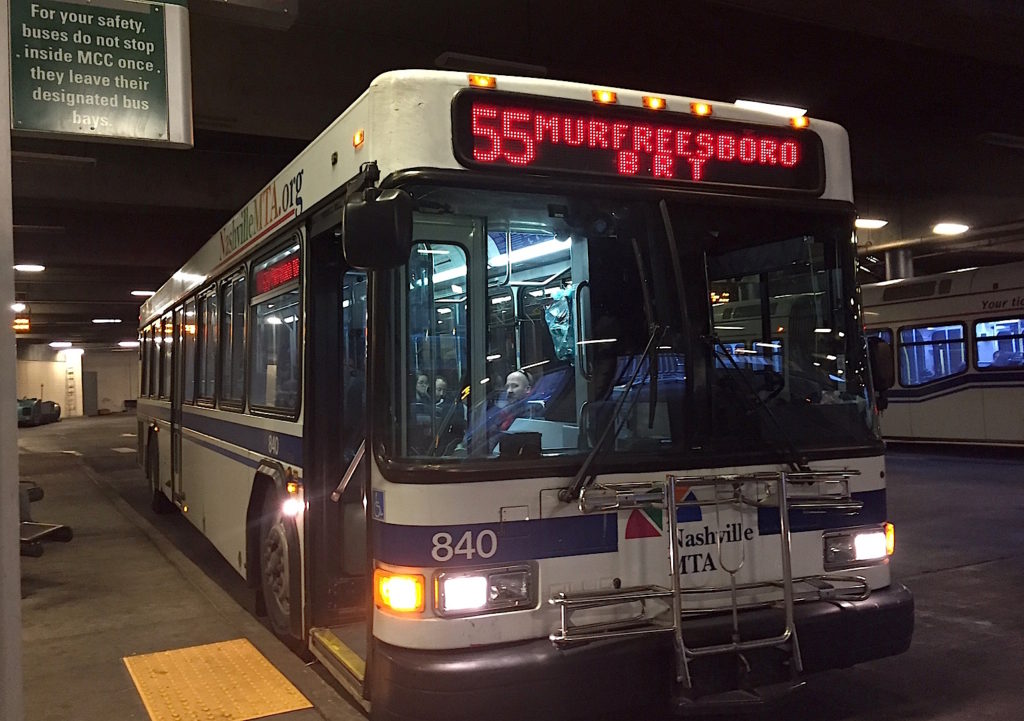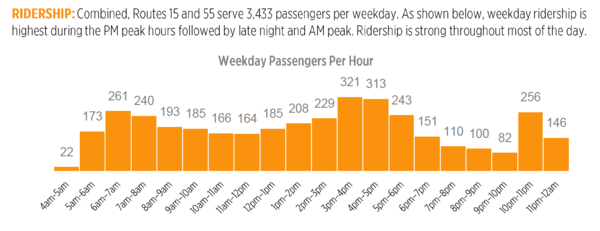
For the first time, some Nashville buses are about to get an advantage on the roads, instead of being thrown in the mix with general traffic.
Changes are coming to lanes and stoplights along Murfreesboro Road in Southeast Nashville, home to the second-highest bus ridership in the city. And officials say this project is unique in that it gives priority to public transit — a sign of things to come in other ambitious plans for the future.
The challenge in that corridor is especially dense congestion, which grinds down buses to average speeds of as low as 2 mph in downtown during rush hour, and still a middling 14 mph as far out as Nashboro Village.
The daily situation gives Express Route 55 riders like Angela Barbour, a state employee, a sense of helplessness.
“It’s really just Murfreesboro Road itself. It’s just a road that generates a lot of traffic, so there’s not too much the bus can do,” she said.
Barbour is right — at least about the difficulty of changing road capacity. And like the 3,300 daily riders on this route, transit users want reliable, on-time service.

“They could run a little bit on time, instead of making us late for work,” said Kimberly Franklin, who rides to her son’s school and to work on weekdays.
Nashville Tries Something New
Leaders with the Nashville Metropolitan Transit Authority say they sympathize.
“You can’t just get to work on time 87 percent of the time,” said MTA engineer Michael White.
So he’s now overseeing a $13.7 million project — mostly federal funds from 2013 — to improve 41 aging intersections along an 11-mile stretch.
Right now, the traffic signals dangle from cords strung across old-fashioned wooden poles. And sidewalks are rare near bus stops. All of that will change.
And two relatively new ideas, locally at least, will give special preference to buses.

“Nobody wants to ride behind the bus or let the bus back in, and so our buses get stuck on the side of the road and can’t enter back into traffic,” White said. “The idea is to keep the bus out of the congestion.”
To do that, buses will get their own lanes in some places — just for short stretches, right before intersections. At red lights, buses will swing over, move to the front of traffic, and then get a special green light for a few seconds, to get rolling and make up time.
This is called a “queue jump,” and it’s a first for Nashville.
In addition, a high-tech stoplight system will know where the buses are and automatically alter the green lights to keep them moving. This is also new, greatly extending a technology used in small ways along Gallatin Pike.
Bus riders like the idea.
“To manipulate the stoplights, huh?” said daily rider Kevin Jones, who works in construction. “I guess that’s OK if you’re on the bus. I don’t know about if you’re in the car on the other side waiting to come though!”
For those in cars, the MTA said the change shouldn’t be all that noticeable. When work begins in 2017, the project could take 18 months. As intersections are upgraded, they will immediately come on line with the new technology.
MTA will be tracking bus performance, and it’s possible the project will make the case for the same kind of transit priority in other busy areas.
More Transit To Come
The “Southeast Corridor” has received other close attention in transit studies, as it could eventually be home to light rail service, including to Nashville International Airport.
That’s far off, but MTA Planning Director Felix Castrodad calls the bus priority project a “first step.”
“This is going to help us to see how transit priority can do,” he said.
Meanwhile, MTA is preparing a Metro funding request to increase the hours and frequencies of bus service on several corridors. Those improvements were roundly
requested in this year’s nMotion transit planning process.

And Jones, the bus rider, said he would like to see a few additional stops on the Express Route 55.
“You may have to run if you see [it] coming,” he said.
That concern has been raised by transit planners, who worry about large distances between some stations on Murfreesboro Road.


